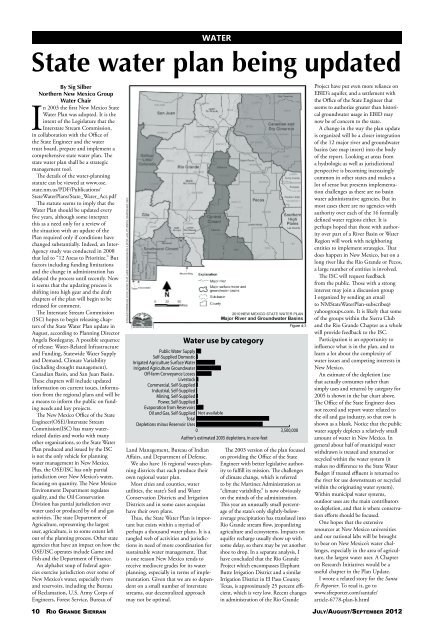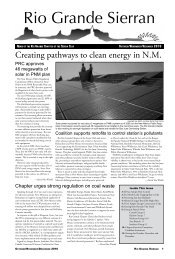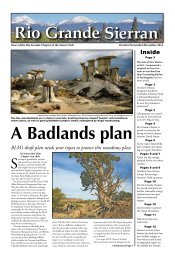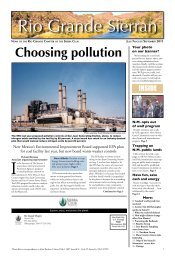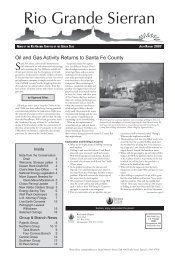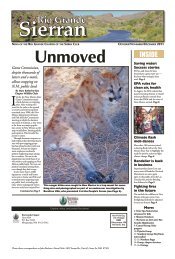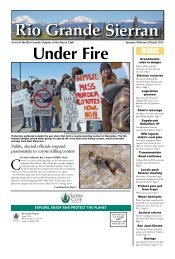Coal kills - Rio Grande Chapter
Coal kills - Rio Grande Chapter
Coal kills - Rio Grande Chapter
Create successful ePaper yourself
Turn your PDF publications into a flip-book with our unique Google optimized e-Paper software.
WATER<br />
State water plan being updated<br />
By Sig Silber<br />
Northern New Mexico Group<br />
Water Chair<br />
In 2003 the first New Mexico State<br />
Water Plan was adopted. It is the<br />
intent of the Legislature that the<br />
Interstate Stream Commission,<br />
in collaboration with the Office of<br />
the State Engineer and the water<br />
trust board, prepare and implement a<br />
comprehensive state water plan. The<br />
state water plan shall be a strategic<br />
management tool.<br />
The details of the water-planning<br />
statute can be viewed at www.ose.<br />
state.nm.us/PDF/Publications/<br />
StateWaterPlans/State_Water_Act.pdf<br />
The statute seems to imply that the<br />
Water Plan should be updated every<br />
five years, although some interpret<br />
this as a need only for a review of<br />
the situation with an update of the<br />
Plan required only if conditions have<br />
changed substantially. Indeed, an Inter-<br />
Agency study was conducted in 2008<br />
that led to “12 Areas to Prioritize.” But<br />
factors including funding limitations<br />
and the change in administration has<br />
delayed the process until recently. Now<br />
it seems that the updating process is<br />
shifting into high gear and the draft<br />
chapters of the plan will begin to be<br />
released for comment.<br />
The Interstate Stream Commission<br />
(ISC) hopes to begin releasing chapters<br />
of the State Water Plan update in<br />
August, according to Planning Director<br />
Angela Bordegaray. A possible sequence<br />
of release: Water-Related Infrastructure<br />
and Funding, Statewide Water Supply<br />
and Demand, Climate Variability<br />
(including drought management),<br />
Canadian Basin, and San Juan Basin.<br />
These chapters will include updated<br />
information on current issues, information<br />
from the regional plans and will be<br />
a means to inform the public on funding<br />
needs and key projects.<br />
The New Mexico Office of the State<br />
Engineer(OSE)/Interstate Stream<br />
Commission(ISC) has many waterrelated<br />
duties and works with many<br />
other organizations, so the State Water<br />
Plan produced and issued by the ISC<br />
is not the only vehicle for planning<br />
water management in New Mexico.<br />
Plus, the OSE/ISC has only partial<br />
jurisdiction over New Mexico’s water,<br />
focusing on quantity. The New Mexico<br />
Environment Department regulates<br />
quality, and the Oil Conservation<br />
Division has partial jurisdiction over<br />
water used or produced by oil and gas<br />
activities. The state Department of<br />
Agriculture, representing the largest<br />
user, agriculture, is to some extent left<br />
out of the planning process. Other state<br />
agencies that have an impact on how the<br />
OSE/ISC operates include Game and<br />
Fish and the Department of Finance.<br />
An alphabet soup of federal agencies<br />
exercise jurisdiction over some of<br />
New Mexico’s water, especially rivers<br />
and reservoirs, including the Bureau<br />
of Reclamation, U.S. Army Corps of<br />
Engineers, Forest Service, Bureau of<br />
Public Water Supply<br />
Self-Supplied Domestic<br />
Irrigated Agriculture Surface Water<br />
Irrigated Agriculture Groundwater<br />
Off-farm Conveyance Losses<br />
Livestock<br />
Commercial, Self-Supplied<br />
Industrial, Self-Supplied<br />
Mining, Self-Supplied<br />
Power, Self-Supplied<br />
Evaporation from Reservoirs<br />
Oil and Gas, Self-Supplied Not available<br />
Total<br />
Depletions minus Reservoir Uses<br />
0 3,500,000<br />
Author's estimated 2005 depletions, in acre-feet<br />
Land Management, Bureau of Indian<br />
Affairs, and Department of Defense.<br />
We also have 16 regional water-planning<br />
districts that each produce their<br />
own regional water plan.<br />
Most cities and counties, water<br />
utilities, the state’s Soil and Water<br />
Conservation Districts and Irrigation<br />
Districts and in some cases acequias<br />
have their own plans.<br />
Thus, the State Water Plan is important<br />
but exists within a myriad of<br />
perhaps a thousand water plans. It is a<br />
tangled web of activities and jurisdictions<br />
in need of more coordination for<br />
sustainable water management. That<br />
is one reason New Mexico tends to<br />
receive mediocre grades for its water<br />
planning, especially in terms of implementation.<br />
Given that we are so dependent<br />
on a small number of interstate<br />
streams, our decentralized approach<br />
may not be optimal.<br />
Water use by category<br />
The 2003 version of the plan focused<br />
on providing the Office of the State<br />
Engineer with better legislative authority<br />
to fulfill its mission. The challenges<br />
of climate change, which is referred<br />
to by the Martinez Administration as<br />
“climate variability,” is now obviously<br />
on the minds of the administration.<br />
This year an unusually small percentage<br />
of the state’s only slightly-belowaverage<br />
precipitation has translated into<br />
<strong>Rio</strong> <strong>Grande</strong> stream flow, jeopardizing<br />
agriculture and ecosystems. Impacts on<br />
aquifer recharge usually show up with<br />
some delay, so there may be yet another<br />
shoe to drop. In a separate analysis, I<br />
have concluded that the <strong>Rio</strong> <strong>Grande</strong><br />
Project which encompasses Elephant<br />
Butte Irrigation District and a similar<br />
Irrigation District in El Paso County,<br />
Texas, is approximately 25 percent efficient,<br />
which is very low. Recent changes<br />
in administration of the <strong>Rio</strong> <strong>Grande</strong><br />
Project have put even more reliance on<br />
EBID’s aquifer, and a settlement with<br />
the Office of the State Engineer that<br />
seems to authorize greater than historical<br />
groundwater usage in EBID may<br />
now be of concern to the state.<br />
A change in the way the plan update<br />
is organized will be a closer integration<br />
of the 12 major river and groundwater<br />
basins (see map insert) into the body<br />
of the report. Looking at areas from<br />
a hydrologic as well as jurisdictional<br />
perspective is becoming increasingly<br />
common in other states and makes a<br />
lot of sense but presents implementation<br />
challenges as there are no basin<br />
water administrative agencies. But in<br />
most cases there are no agencies with<br />
authority over each of the 16 formally<br />
defined water regions either. It is<br />
perhaps hoped that those with authority<br />
over part of a River Basin or Water<br />
Region will work with neighboring<br />
entities to implement strategies. That<br />
does happen in New Mexico, but on a<br />
long river like the <strong>Rio</strong> <strong>Grande</strong> or Pecos,<br />
a large number of entities is involved.<br />
The ISC will request feedback<br />
from the public. Those with a strong<br />
interest may join a discussion group<br />
I organized by sending an email<br />
to NMStateWaterPlan-subscribe@<br />
yahoogroups.com. It is likely that some<br />
of the groups within the Sierra Club<br />
and the <strong>Rio</strong> <strong>Grande</strong> <strong>Chapter</strong> as a whole<br />
will provide feedback to the ISC.<br />
Participation is an opportunity to<br />
influence what is in the plan, and to<br />
learn a lot about the complexity of<br />
water issues and competing interests in<br />
New Mexico.<br />
An estimate of the depletion (use<br />
that actually consumes rather than<br />
simply uses and returns) by category for<br />
2005 is shown in the bar chart above.<br />
The Office of the State Engineer does<br />
not record and report water related to<br />
the oil and gas industry, so that row is<br />
shown as a blank. Notice that the public<br />
water supply depletes a relatively small<br />
amount of water in New Mexico. In<br />
general about half of municipal water<br />
withdrawn is treated and returned or<br />
recycled within the water system (it<br />
makes no difference to the State Water<br />
Budget if treated effluent is returned to<br />
the river for use downstream or recycled<br />
within the originating water system).<br />
Within municipal water systems,<br />
outdoor uses are the main contributors<br />
to depletion, and that is where conservation<br />
efforts should be focused.<br />
One hopes that the extensive<br />
resources at New Mexico universities<br />
and our national labs will be brought<br />
to bear on New Mexico’s water challenges,<br />
especially in the area of agriculture,<br />
the largest water user. A <strong>Chapter</strong><br />
on Research Initiatives would be a<br />
useful chapter in the Plan Update.<br />
I wrote a related story for the Santa<br />
Fe Reporter. To read it, go to<br />
www.sfreporter.com/santafe/<br />
article-6778-plan-b.html<br />
10 <strong>Rio</strong> <strong>Grande</strong> Sierran July/August/September 2012


